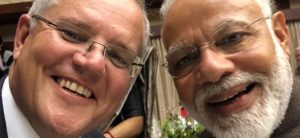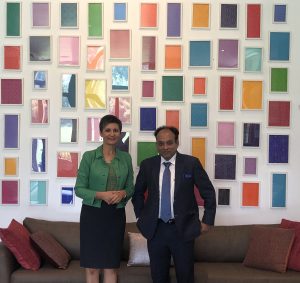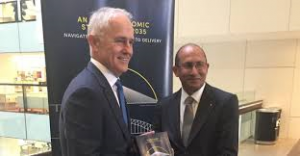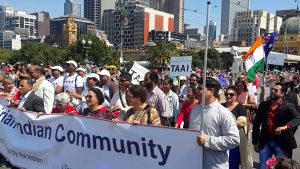
Against the backdrop of ongoing geopolitical realignments and growing economic synergies, India’s multi-faceted relations with Australia are poised to move into a higher orbit. Building on their complementary strengths and capabilities, the two countries are set to scale up their economic partnership, a process that has acquired a new energy after the publication of “An India Economic Strategy to 2035” paper by Peter Varghese and endorsed by the Australian Government last year. On the strategic plane, shared strategic interests and near identical values are propelling the two countries into a closer strategic partnership, both bilaterally and in mini-lateral formats like the Quad.

As India and Australia celebrate the 75th anniversary of the establishment of their diplomatic relations, Australia’s High Commissioner to India Harinder Sidhu speaks to Manish Chand, Editor-in-Chief, India and World& India Writes Network, about latest developments in this rapidly growing partnership and her vision of where it is headed in years to come. “There is no reason why Australia and India cannot have the strongest partnership of any two countries in the Indo-Pacific,” says the Indian-born Sidhu in this free-wheeling conversation with India and World.
(Excerpts from the interview)
Q) Over the years, India and Australia have forged a robust strategic and economic partnership. Can one expect the current momentum in India-Australia relations to continue under the new dispensation in New Delhi and Canberra?
A) In the last few years, we built a very strong strategic partnership, and we are in the process of building a very strong economic partnership. The driving force behind the relationship has been an understanding on both sides on how well strategically aligned we are. This relationship is being built on a very clear understanding of shared national interests.
One shared strategic element is that we are both democracies. During a recent trip to Mumbai, I visited some of the polling stations there. Watching Indians go to the elections is like watching Australians go to the elections — there is a same feeling in the air.
Enhancing Economic Ties
Q) Australia’s foreign policy has identified India as a priority country. India-Australia economic relations are on an upward curve, but given the potential, the economic partnership is still underperforming. Last year, former foreign secretary Peter Varghese delivered “An India Economic Strategy to 2035”, . Building on this document, how do you see India and Australia intensifying economic relations in days to come?

A) Both countries have thought it worth our while to invest time, energy and resources in thinking about how we will take the economic relationship forward. The India Economic Strategy is more than 500 pages long; it’s a serious document. It took us more than one year to develop. It’s a mark of our seriousness of intent. But you are right that it’s an underdone economic relationship. India’s share of Australia’s global trade of goods and services is about 3.6% of our global goods and services trade. India is, however, still our fifth largest trading partner. But that 3.6% is what we trade with New Zealand – so there is no comparison in the size of the market. There is a lot of scope. As we move forward in implementing the India Economic Strategy, we have identified 10 priority economic sectors to work in: the four leading sectors are education, tourism, resources and agri business. We are looking on how to strengthen and deepen this economic relationship in these areas.
We are aiming to develop an economic relationship with India, which will not resemble what we have with any other Asian country. It will be very focused on people-to-people links; it will be highly services-focused and very consumption-driven. We are now examining how both India and Australia can derive maximum benefits from this economic relationship.
I am very interested to see the reverse Australia economic strategy that the Indian government is producing. We will be closely looking at areas where we can really form partnerships.
Q) What about the status of CECA (Comprehensive Economic Cooperation Agreement)? The India-Australia CECA remains a work in progress, and continues to be mired in fundamental differences.
A) Nobody ever pretends that negotiating a free-trade agreement is a simple task. The text of the CECA is more than 1,000-pages long. It’s complex and will take time. The reason we commissioned the India Economic Strategy is a recognition that a free-trade agreement alone is not an economic relationship. The economic relationship is going to be bigger than that. Trade will continue in the absence of a free-trade agreement. There are opportunities on both sides that we risk missing because we are so focused on the free-trade agreement alone.
We have to, therefore, see the economic relationship as CECA plus, and not just CECA. I am very confident that we will have a free-trade agreement between India and Australia at some point in the future. Both countries are committed to it; it is something that we continue to work on, but it’s not the only thing we are going to do together. The CECA is a tool and an enabler to accelerate what we are trying to do in the larger economic relationship. For example, some Australian professional qualifications are not recognised in India, and if they were recognised, we can see much more flow of services.
Q) How do you look at the progress in the RCEP (Regional Comprehensive Economic Partnership) negotiations?
A) The RCEP has several tracks. There are tracks for countries who have a free-trade agreement (FTA) with each other, and tracks for those who don’t have FTAs with each other. Australia and India fall into that category of countries who don’t have FTAs; so, we have to agree to things bilaterally before we can bring it to the group. I am actually quite optimistic about the RCEP; we have made quite a lot of progress in recent times. The Indian government is very seized of the importance of the RCEP. I always worry about putting a timeline on trade agreements – this is always a dangerous thing because that becomes the success point rather than the quality of it. The RCEP is extraordinarily important for India as it’s the first significant regional trade agreement that India has been involved in. It’s an Indo-Pacific trade agreement; it will have an enormous impact on economic integration. If we can conclude the RCEP, there would be a tremendous boost to the economic cohesion of the Indo-Pacific, just by virtue of the trading relationships that we’ve built.
Partnering in Indo-Pacific
Q) The Indo-Pacific has acquired a new salience in the foreign policy matrix of both India and Australia. How do you envisage cooperation between India and Australia in the Indo-Pacific region?

A) Australia has been using the phrase Indo-Pacific for about 10 years. It was, however, only in 2017 that we articulated our goals in the Indo-Pacific, and they fall into several categories. One is to continue to deepen and strengthen our alliance with the United States; the second is building a constructive relationship with China. The third is ASEAN centrality – working very hard with Southeast Asian nations. The fourth is building our relationship in the Pacific (because the Pacific is home and backyard for Australia) and with significant Indo-Pacific democracies such as India, Japan and Indonesia.
We have set out a number of goals in the Indo-Pacific; and collectively, they set out what kind of Indo-Pacific we want. We always talk about stability and security, but actually what we want is not just a stable and secure Indo-Pacific region, but a region that is actually free and open at the same time — where you can conduct business freely, trade flows freely and where the country’s sovereignty is protected.
Regional Connectivity
Q) Talking about Indo-Pacific cooperation, connectivity and infrastructure building have become focus areas as well as areas of contestation. For example, the China-led Belt and Road Initiative (BRI) continues to spark different assessments from different players. How is Australia approaching regional connectivity in the Indo-Pacific through initiatives like the South Asia Regional Infrastructure Connectivity Initiative (SARIC)? In what ways can India and Australia partner in promoting regional connectivity?
A) The Indo-Pacific is a big region so it’s important for every country to contribute in those regions that make sense for them. In Australia’s case, we have announced a number of very significant initiatives. We have announced very large initiatives in the Pacific. This includes setting up the Australian Infrastructure Financing Facility for countries in the Pacific region with a $2 billion fund and an increase to $1 billion in callable capital to Export Finance and Infrastructure Corporation (EFIC), Australia’s export financing agency. There are other specific initiatives like an agreement with Fiji to redevelop Blackrock Peacekeeping and Humanitarian Assistance and Disaster Relief Camp. We have undertaken similar initiatives in Southeast Asia and South Asia. In January this year, our foreign minister announced $25 million for the first phase of SARIC, which is focused on a few sectors, including energy. It’s also a recognition of where Australia can bring its strengths to bear in contributing to connectivity goals in South Asia.
Q) What is Australia’s view of the Belt and Road Initiative?
A) Bringing countries together to invest in infrastructure to build the capacity is a good thing; it’s what we are doing ourselves in the Pacific, Southeast Asia and South Asia. But that has be done in an open and transparent way, and which respects the sovereignty of the countries involved. We have to also ensure that connectivity projects don’t lead to overly burdensome debt obligations; and where the benefit clearly flows to the receiving country. As an election campaign was underway in Australia, we did not send anyone to the Belt and Road Forum (BRF) at the ministerial level. We participated in the BRF at the level of officials.
Whither Quad?
Q) How do you look at the future of the Quad? There are some experts and diplomats who are pitching for upgrading the Quad to the ministerial level, and then there are some who advocate an incremental approach. How will Australia like to see the Quad moving?
A) The world is very different now to when the Quad was first instituted in 2007. The habits of what we are calling mini-lateral diplomacy are much more common now; it’s not just Australia, but just about every other country is used to meeting in small groups. You can actually name many, like trilateral arrangements, there’s BRICS, BIMSTEC and other small regional organisations. Australia has a number of trilateral arrangements for some time, and small arrangements that have gone beyond trilateral to four or five countries. The Quad is just one of them. When the Quad was reinstituted in 2017, it was reinstituted in an environment that is so complex that you really need to talk in small groups to build cooperation. It is a diplomatic dialogue mechanism to build confidence between countries, and it is one of a series of mechanisms in that sense. When you are building confidence with the countries you have to work with, you have to walk before you can run. Why is everyone in a tearing hurry to raise the Quad to the ministerial level? It may get there one day, but we have many other trilaterals that are much more evolved, but are still not at the ministerial level. So, let’s just take it a step at a time. From where I sit, the Quad is doing extremely well; the relationships are clearer; the agenda is more defined – there is a wider range of issues that people are talking about in the Quad. It’s creating a very positive dynamic.
Q) What are Australia’s priorities and expectations vis a vis the Quad? What exactly do you wish to achieve through the Quad? Many experts are prone to portray the Quad as an instrument of China containment. What’s your assessment?
A) I don’t think we should be in that business [of China containment.I don’t think that is what the Quad is about. What we want from the Quad is to build trust and understanding amongst these four key like-minded Indo-Pacific democracies. In everything from the economic to the strategic, the Quad will really start to show its value when we start putting practical cooperation in place.
Counter-terror Cooperation
Q) The recent terror attack in Pulwama in Jammu and Kashmir once again reminded the world of cross-border terrorism flowing from Pakistan. And the Easter massacre in Sri Lanka has highlighted the rising threat of the Islamic State. Australia is also grappling with the problem of the Islamic State radicalisation. In what ways can India and Australia enhance their counter terror cooperation?
A) We in Australia were very sad at the Pulwama attack and were quick to express our condolences – the same goes with Sri Lanka. These are horrific things that should not happen to anybody.
Now, we have a number of arrangements on counter-terror cooperation with the Indian government in different formats. We have a specific standing and working group between India and Australia on counter terrorism alone. We have an ambassador for counter terrorism, and they meet very regularly – that’s when we talk about the nuts and bolts of counter-terrorism cooperation. When you talk of asymmetric international threats, terrorism is only one of the related threats like cyber-crimes, people smuggling and human trafficking and narcotics trade.
The agreement we signed with India in 2017 created a mechanism between the Australian Home Affairs department and India’s Ministry of Home Affairs to look at all these transnational crimes and transnational threats. What India is facing is very different from what Australia is facing and what other countries are facing. We have known since 9/11 that to build counter terrorism capability is to share information with each other. But now we are also sharing approaches to counter radicalisation.
In Australia, for example, we have very large population that comes from all sorts of background. We are very concerned about some of our youth being radicalised. We haven’t seen any home-grown terrorism, but we have seen a lot of people inspired by the Islamic State. We have seen a number of people go to the Middle East to fight for Islamic State. Often these are young Australian-born people: that’s been a source of great concern. It’s caused our government to think very carefully about how we work with our communities particularly our Muslim communities so that they don’t feel isolated and alienated. We know that by working with them, and including them and engaging with these communities, we are likely to bring the temperature down. We have learned a lot from India in this area as well.
Indian Diaspora
Q) It’s great to have an Australian High Commissioner in India with Harinder as her first name and Sidhu as surname. How do you explain the unfolding success story of the Indian diaspora in Australia?

A) Australia is a very diverse multi-cultural country; we have got people from 200 different backgrounds in Australia, all of whom have made a fantastic contribution to our country. The Indian diaspora is now the fastest growing in Australia, and at last count we had around 70,000 Australians of Indian Origin. This includes around half a million Australian-Indians who were born in India, which works out to 2% of our population. So, 1 in 50 Australians was born in India. The Indian diaspora has grown significantly in the last decade – the population of Indian-born Australians has more than tripled in the last decade.
I am very optimistic about what the Indian diaspora can achieve in Australia in the coming years. As the diaspora matures, it’s going to play a bigger and bigger role in the Australian system. The Indian diaspora in Australia is still very young. Most people who have come to Australia in the last 10 years are young people. You can already see the change. In the state of Western Australia, despite being young, five people of Indian origin were elected to the parliament in the last election. That’s phenomenal! Young Indians are also getting into business and government.
The Long View
Q) India-Australia relations often gets confused with 3C’s: Cricket, Commerce and Curry. Taking a long-range view, how do you see the future of India-Australia relations?
A) This year is the 75th anniversary of the establishment of diplomatic relations between India and Australia. We established diplomatic relations before independence – the first Australian High Commissioner arrived in New Delhi in January 1944. Therefore, it seems to me a terrible shame that the two countries that are so similar in the things we value and the way we look at the world – the best we can say about the last 70 years are the three Cs. Surely, we could do more than that. What I see us heading towards is two countries that I believe should be the strongest friends in the Indo-Pacific. There is no reason why Australia and India cannot have the strongest partnershipof any two countries in the Indo-Pacific. We both are democracies, we both look at the world the same way, we both have complementary economies, we both have almost identical strategic interests, and we both have far more in common than we have things that are different. When an Australian and an Indian sit down together, the conversation is easy, open and free. What I am really happy to see is that’s exactly where it’s going.
Author Profile
- India Writes Network (www.indiawrites.org) is an emerging think tank and a media-publishing company focused on international affairs & the India Story. Centre for Global India Insights is the research arm of India Writes Network. To subscribe to India and the World, write to editor@indiawrites.org. A venture of TGII Media Private Limited, a leading media, publishing and consultancy company, IWN has carved a niche for balanced and exhaustive reporting and analysis of international affairs. Eminent personalities, politicians, diplomats, authors, strategy gurus and news-makers have contributed to India Writes Network, as also “India and the World,” a magazine focused on global affairs.
Latest entries
 DiplomacyOctober 4, 2025UNGA Resolution 2758 Must Not Be Distorted, One-China Principle Brooks No Challenge
DiplomacyOctober 4, 2025UNGA Resolution 2758 Must Not Be Distorted, One-China Principle Brooks No Challenge India and the WorldJuly 26, 2025MPs, diplomats laud Operation Sindoor, call for national unity to combat Pakistan-sponsored terror
India and the WorldJuly 26, 2025MPs, diplomats laud Operation Sindoor, call for national unity to combat Pakistan-sponsored terror India and the WorldJuly 25, 2025When Fire Ends, Diplomacy Begins
India and the WorldJuly 25, 2025When Fire Ends, Diplomacy Begins India and the WorldJuly 16, 2025Operation Sindoor and its Aftermath: India’s Successful Diplomatic Outreach
India and the WorldJuly 16, 2025Operation Sindoor and its Aftermath: India’s Successful Diplomatic Outreach







